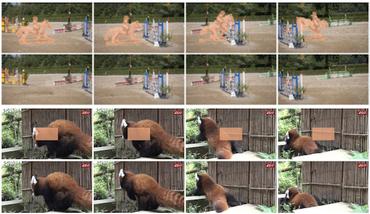Search Results for author: Chang Sun
Found 12 papers, 2 papers with code
JEP-KD: Joint-Embedding Predictive Architecture Based Knowledge Distillation for Visual Speech Recognition
no code implementations • 4 Mar 2024 • Chang Sun, Hong Yang, Bo Qin
Visual Speech Recognition (VSR) tasks are generally recognized to have a lower theoretical performance ceiling than Automatic Speech Recognition (ASR), owing to the inherent limitations of conveying semantic information visually.
 Automatic Speech Recognition
Automatic Speech Recognition
 Automatic Speech Recognition (ASR)
+3
Automatic Speech Recognition (ASR)
+3
KDSM: An uplift modeling framework based on knowledge distillation and sample matching
no code implementations • 6 Mar 2023 • Chang Sun, Qianying Li, Guanxiang Wang, Sihao Xu, Yitong Liu
The teacher model is the uplift decision tree (UpliftDT), whose structure is exploited to construct counterfactual sample pairs, and the pairwise incremental prediction is treated as another objective for the student model.
TAPS Responsibility Matrix: A tool for responsible data science by design
no code implementations • 2 Feb 2023 • Visara Urovi, Remzi Celebi, Chang Sun, Linda Rieswijk, Michael Erard, Arif Yilmaz, Kody Moodley, Parveen Kumar, Michel Dumontier
However, guidance on the responsibilities of the data scientists and the other involved actors in a data science project is typically missing.
Physical Logic Enhanced Network for Small-Sample Bi-Layer Metallic Tubes Bending Springback Prediction
no code implementations • 20 Sep 2022 • Chang Sun, Zili Wang, Shuyou Zhang, Le Wang, Jianrong Tan
In the second stage, under the physical logic, the PE-NET is assembled by ES-NET and SP-NET and then fine-tuned with the small sample BMT dataset and composite loss function.
Digital-twin-enhanced metal tube bending forming real-time prediction method based on Multi-source-input MTL
1 code implementation • 3 Jul 2022 • Chang Sun, Zili Wang, Shuyou Zhang, Taotao Zhou, Jie Li, Jianrong Tan
To address this issue, a digital-twin-enhanced (DT-enhanced) metal tube bending forming real-time prediction method based on multi-source-input multi-task learning (MTL) is proposed.
Improving Correlation Capture in Generating Imbalanced Data using Differentially Private Conditional GANs
no code implementations • 28 Jun 2022 • Chang Sun, Johan van Soest, Michel Dumontier
Finally, we present the balance between data utility and privacy in synthetic data generation considering the different data structure and characteristics of real-world datasets such as imbalance variables, abnormal distributions, and sparsity of data.
A Lightweight Dual-Domain Attention Framework for Sparse-View CT Reconstruction
no code implementations • 19 Feb 2022 • Chang Sun, Ken Deng, Yitong Liu, Hongwen Yang
After the restored Radon data is reconstructed to an image, the image is sent into the second CAGAN trained for recovering the details, so that a high-quality image is obtained.
A Lightweight Structure Aimed to Utilize Spatial Correlation for Sparse-View CT Reconstruction
no code implementations • 19 Jan 2021 • Yitong Liu, Ken Deng, Chang Sun, Hongwen Yang
Sparse-view computed tomography (CT) is known as a widely used approach to reduce radiation dose while accelerating imaging through lowered projection views and correlated calculations.
Real-Time Limited-View CT Inpainting and Reconstruction with Dual Domain Based on Spatial Information
no code implementations • 19 Jan 2021 • Ken Deng, Chang Sun, Yitong Liu, Hongwen Yang
In stage one, to better utilize prior information in the Radon domain, we design an adversarial autoencoder to complement the Radon data.
Knowledge Graphs Evolution and Preservation -- A Technical Report from ISWS 2019
no code implementations • 22 Dec 2020 • Nacira Abbas, Kholoud Alghamdi, Mortaza Alinam, Francesca Alloatti, Glenda Amaral, Claudia d'Amato, Luigi Asprino, Martin Beno, Felix Bensmann, Russa Biswas, Ling Cai, Riley Capshaw, Valentina Anita Carriero, Irene Celino, Amine Dadoun, Stefano De Giorgis, Harm Delva, John Domingue, Michel Dumontier, Vincent Emonet, Marieke van Erp, Paola Espinoza Arias, Omaima Fallatah, Sebastián Ferrada, Marc Gallofré Ocaña, Michalis Georgiou, Genet Asefa Gesese, Frances Gillis-Webber, Francesca Giovannetti, Marìa Granados Buey, Ismail Harrando, Ivan Heibi, Vitor Horta, Laurine Huber, Federico Igne, Mohamad Yaser Jaradeh, Neha Keshan, Aneta Koleva, Bilal Koteich, Kabul Kurniawan, Mengya Liu, Chuangtao Ma, Lientje Maas, Martin Mansfield, Fabio Mariani, Eleonora Marzi, Sepideh Mesbah, Maheshkumar Mistry, Alba Catalina Morales Tirado, Anna Nguyen, Viet Bach Nguyen, Allard Oelen, Valentina Pasqual, Heiko Paulheim, Axel Polleres, Margherita Porena, Jan Portisch, Valentina Presutti, Kader Pustu-Iren, Ariam Rivas Mendez, Soheil Roshankish, Sebastian Rudolph, Harald Sack, Ahmad Sakor, Jaime Salas, Thomas Schleider, Meilin Shi, Gianmarco Spinaci, Chang Sun, Tabea Tietz, Molka Tounsi Dhouib, Alessandro Umbrico, Wouter van den Berg, Weiqin Xu
Although linked open data (LOD) is one knowledge graph, it is the closest realisation (and probably the only one) to a public FAIR Knowledge Graph (KG) of everything.
Deep reinforcement learning for optical systems: A case study of mode-locked lasers
no code implementations • 10 Jun 2020 • Chang Sun, Eurika Kaiser, Steven L. Brunton, J. Nathan Kutz
We demonstrate that deep reinforcement learning (deep RL) provides a highly effective strategy for the control and self-tuning of optical systems.
Privacy-Preserving Generalized Linear Models using Distributed Block Coordinate Descent
1 code implementation • 8 Nov 2019 • Erik-Jan van Kesteren, Chang Sun, Daniel L. Oberski, Michel Dumontier, Lianne Ippel
We conclude that our method is a viable approach for vertically partitioned data analysis with a wide range of real-world applications.


